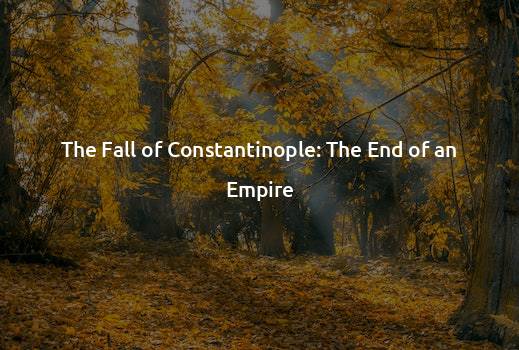The Fall of Constantinople: The End of an Empire
The Fall of Constantinople: The End of an Empire
On May 29, 1453, after a grueling siege that lasted for seven weeks, Constantinople, the capital of the Byzantine Empire, fell into the hands of Ottoman Sultan Mehmed the Conqueror. This marked the end of an era, the fall of an empire that had withstood numerous assaults for over a thousand years.
The Byzantine Empire: A Glorious Legacy
Founded in 330 AD by Emperor Constantine the Great, Constantinople had been the heart of the Byzantine Empire, the eastern counterpart to the ancient Roman Empire. Throughout its existence, the empire had faced numerous challenges from internal conflicts and external invasions.
Despite these challenges, Constantinople thrived as a cultural, economic, and political powerhouse. Its strategic location between Europe and Asia allowed it to command trade routes and amass vast wealth, while its architectural wonders, such as the Hagia Sophia, showcased the empire’s grandeur.
For centuries, the empire had faced threats from various enemies, including Arab armies, Bulgarian and Serbian kingdoms, and Latin Crusaders. However, it managed to survive and even flourish, constantly adapting to changing times.
The Ottoman Threat: The Siege Begins
The Ottoman Empire, under the leadership of Mehmed the Conqueror, finally posed a threat that the Byzantine Empire could not overcome. The young Sultan, determined to make Constantinople the jewel in his empire’s crown, assembled a massive army and set his sights on capturing the city.
The siege began on April 6, 1453, with Mehmed’s forces surrounding Constantinople, cutting off vital supply routes, and bombarding the city walls relentlessly. The Byzantines, led by Emperor Constantine XI Palaiologos, were vastly outnumbered and struggled to fend off the Ottoman onslaught.
Despite their valiant efforts, the Byzantines were no match for the superior Ottoman forces. The city’s defenses weakened by continuous bombardment and several unsuccessful attempts to break the siege, Constantinople’s fate seemed inevitable.
The Final Assault: The End of an Era
On May 29, 1453, the Ottoman forces launched a final, relentless assault on Constantinople. They breached the city’s defenses at the vulnerable spot known as the Kerkoporta, overwhelming the few remaining defenders.
Emperor Constantine XI Palaiologos led his troops in a desperate last stand but was soon killed in the chaos of battle. With their leader dead and the city falling into chaos, the remaining Byzantine soldiers fought bravely, but they were hopelessly outnumbered and outgunned.
As Ottoman soldiers poured into the city, looting and pillaging ensued. The once-glorious capital was ravaged, and countless treasures were lost forever. Churches were converted into mosques, and the Hagia Sophia, once a symbol of Christian power, was converted into an Islamic mosque, forever altering the city’s skyline.
The Legacy and Impact
The fall of Constantinople sent shockwaves throughout Europe and marked the end of the Byzantine Empire. Its fall had far-reaching consequences, both for the region and the world.
One immediate effect was the disruption of trade between Europe and Asia. Constantinople had been a vital link between the east and the west, and its capture by the Ottomans forced European nations to search for alternative trade routes, gradually leading to the Age of Exploration.
The fall of Constantinople also had a profound cultural impact. Many Byzantine scholars fled westward, carrying with them ancient Greek and Roman texts that had been preserved in the libraries of Constantinople. This influx of knowledge played a crucial role in the revival of classical learning and the development of the Renaissance.
Additionally, the capture of Constantinople allowed the Ottomans to further expand their empire. Over the next few centuries, they would control vast territories, including Southeast Europe, parts of the Middle East, and North Africa, making them a dominant force in the region.
TLDR;
The fall of Constantinople in 1453 marked the end of the Byzantine Empire, which had withstood numerous challenges for over a thousand years. The Ottoman siege, led by Mehmed the Conqueror, proved insurmountable for the Byzantines. After a grueling seven-week siege, the city’s defenses finally crumbled, and Ottoman forces poured in, looting and pillaging. The fall of Constantinople disrupted trade routes, led to the spread of classical knowledge, and allowed the Ottomans to expand their empire. The fall of Constantinople forever changed the political landscape of the region and had far-reaching consequences that shaped the course of history.







